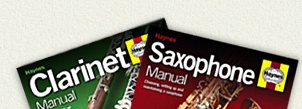Remy tenor saxophone
 Origin:
China Origin:
China
Guide price: £4100
Weight: 3.17kg
Date of manufacture: 2022 (serial range: 24070xxx)
Date reviewed: August 2023
Nearly there...
Boutique horns. You don't see one for months -
and then two come along at once. I recently finished up a review
of a Nexus
tenor in which I described it as a 'Boutweaqued' horn - meaning
an off-the-shelf boutique horn that's been customised for or by
the reseller. And this is exactly what we have here.
I've noticed that some people seem to dislike the whole idea; that
you can buy a horn from a manufacturer, stamp your name on it and
then sell it on to the general public. But it's not really anything
new, it's been going on for decades. Indeed, a quick browse on any
of the sax forums will throw up any number of posts from folks who've
acquired a 'mystery vintage sax' and wish to know who made it.
On the face of it the dislike appears to come
out of the notion that someone, somewhere is making money out of
such business practices - but it's perhaps a little more nuanced
than that.
Walk into any shop and you can buy a product that wasn't made by
the shop owner. It's called retail. Shops buy from manufacturers
and sell those goods on to the public. The profit they make is in
return for providing us with a convenient place from which to purchase
the things we want rather than having to go to the manufacturer...who
will probably require you to buy in bulk.
For boutique horns the nuance is the feeling that Brand X is made
by the same people who make Brand Y and Z, and yet the price difference
between the brands can be substantially different. If you're 'in
the know' you can simply buy the cheapest brand and save yourself
a few hundred quid. I can understand that, because there have been
times when I've seen horns whose origins I'm aware of being hyped
up and sold as more than they really are...and for more than they're
worth.
But it gets a bit complicated when someone takes
a stock horn and customises it. The questions you have to ask yourself
are "What's been done to the stock model?", "What
difference has it made?" and "How much extra am I being
charged for these tweaks?" If you can answer those questions
you can figure out whether the horn is worth the price being asked
- but answering those questions isn't all that easy. This is why
some folks prefer to buy horns from, say, Yamaha - because the company
structure makes such questions moot. All you have to do is find
the best deal on your chosen model and you never have to worry that
someone's selling the same horn under a different name at a grand
or so cheaper.
So when it comes to boutweaqued horns it's always going to be difficult
to pin a value on them - and in the end it pretty much comes down
to comparisons. How does it stack up against the similarly-priced
competition? Does it play well enough to make you feel it's worth
the money?
And what about the point of origin - China (apparently).
For many people that's a big issue - and let's be honest, we've
all seen some appalling kit from there. But this is where the tweakery
comes in because the component parts are made in China to the seller's
specification and then whole lot is reworked and assembled in Amsterdam.
With all this in mind, let's take a look at the
Remy tenor...
The construction is ribbed, with plates for the side keys and a
handful of standalone pillars. There's a two-point Selmer MkVI style
bell brace and a detachable bell. You get a teeny-tiny sling ring
(14/18mm), an adjustable metal thumb hook and a flat plastic thumb
rest - and a full set of adjustable bumper felts.
 The
toneholes are of the plain drawn variety, and measuring them up
against a flat standard revealed that they're below the par that
I'd expect to see on a horn of this price. The
toneholes are of the plain drawn variety, and measuring them up
against a flat standard revealed that they're below the par that
I'd expect to see on a horn of this price.
To be fair I have to point out that not many manufacturers get this
right, so have to make an allowance - but when I see gaps like this
it gets flagged up as a pretty major fail. As a general rule of
thumb a gap of 1 thou (0.025mm) is enough to effect a leak, and
on a standard production horn I really don't want to see gaps much
bigger than a couple of thou (0.05mm).
The gap on this tonehole (low C#) weighs in at 0.4mm. That's a lot.
This was the worst of the bunch, and you could suggest that perhaps
the horn took a knock at some point - but I found gaps of 0.25 on
the low Eb, 0.2 on the low B, 0.15 on the low D and C...and everything
inbetween on almost all the rest. It wasn't until the Bis Bb and
above that the toneholes fell within what I'd consider normal parameters.
 Some
of the solderwork is a bit 'splashy' in places. See that overrun
on the bell brace mount plate? In practical terms it makes no real
difference, and you could even say that it proves there's plenty
of solder beneath the plate. But if someone asked me to solder a
plate on to a horn I'd want to make it as neat a job as possible.
I could let something like this slide on a very much cheaper horn
- but for four grand? Nah. Some
of the solderwork is a bit 'splashy' in places. See that overrun
on the bell brace mount plate? In practical terms it makes no real
difference, and you could even say that it proves there's plenty
of solder beneath the plate. But if someone asked me to solder a
plate on to a horn I'd want to make it as neat a job as possible.
I could let something like this slide on a very much cheaper horn
- but for four grand? Nah.
Especially as this is a bare brass horn. With sloppy soldering under
a coat of lacquer there's pretty much nothing you can do about it
without ruining the finish. No such problems on a bare brass horn
- you can clean up solderwork at any point during the manufacturing
process...and afterwards too.
I wouldn't say the rest of the horn was as untidy
as this, but there were a few other places where things could have
been much neater. Here's the side (chromatic) F# upper pillar, and
I can see two things that aren't quite pukka.
The first is that the pillar base hasn't quite been correctly formed
to the diameter of the body tube. Again, like the bell brace plate,
it's not necessarily a structural problem but at the price-point
it ought to have been better.
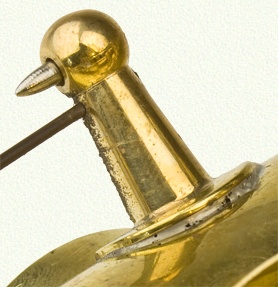 And
then there's the sloppy soldering. This time you can see a few pinholes
in the joint, and this could be a problem. You usually get pinholes
when there's either a problem with the cleanliness of the joint,
or when the joint's been overheated. And you don't know how far
those holes extend under the pillar. This is a concern in terms
of moisture ingress - which can lead to the joint corroding and
failing over time. A long time, admittedly - but a four grand horn
ought to last a very long time. And
then there's the sloppy soldering. This time you can see a few pinholes
in the joint, and this could be a problem. You usually get pinholes
when there's either a problem with the cleanliness of the joint,
or when the joint's been overheated. And you don't know how far
those holes extend under the pillar. This is a concern in terms
of moisture ingress - which can lead to the joint corroding and
failing over time. A long time, admittedly - but a four grand horn
ought to last a very long time.
From my perspective it doesn't inspire confidence.
Issues like this suggest that there was a problem with the soldering
process - and because you can't see beneath the joints you have
to wonder if there are going to be any other problems lying in wait
down the line. And yes, you could say that's true of any horn -
but when you see nicely fitting parts with neat soldered joints
it does rather tend to make you feel that all's going to be well.
On to the action now, and I'm afraid there's another
handful of issues to discuss - the first of which being the swedging
marks on many of the rod screw mounted keys.
You could look at this in two ways - one being that it's good to
see that someone's taken the time and trouble to address some inaccuracies
in the keywork, and on the other hand it raises the question as
to why this was necessary in the first place. Swedging is usually
undertaken to take up wear in the keys or to elongate the barrels
to get rid of axial (end-to-end) play....and these are not things
you should have on a new horn. So that means it must have been built
in at the factory.
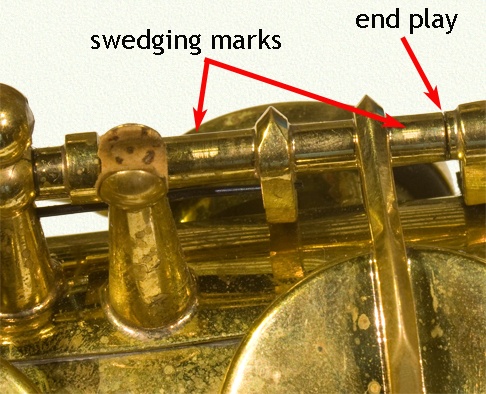 I
also noted that the keys had been 'selectively swedged'. I'm none-too-keen
on this technique - if there's wear/free play in the keys then all
of it ought to be dealt with rather than just a bit of it (see my
article
on swedging for more details). However, if it's just a means
of elongating a key barrel then it's not so much of a big deal -
and it should be noted that at least this remedial work has been
carried out...though not perhaps completely because I found some
axial play in the top stack. I
also noted that the keys had been 'selectively swedged'. I'm none-too-keen
on this technique - if there's wear/free play in the keys then all
of it ought to be dealt with rather than just a bit of it (see my
article
on swedging for more details). However, if it's just a means
of elongating a key barrel then it's not so much of a big deal -
and it should be noted that at least this remedial work has been
carried out...though not perhaps completely because I found some
axial play in the top stack.
I also noticed that quite a few of the key barrels
still had burrs on the ends. This tends to be as a result of using
a rotary cutter to square off the ends. The burrs themselves make
no difference to the functionality of the horn but some of them
can be very sharp. If you're in the habit of cleaning your horn
from time-to-time (and on a bare brass horn that's something you
might have to get used to), these burrs are a bloody nuisance. They
catch on your duster - and in the right circumstances they may even
cut your finger.
 And
it's not like they're at all difficult to remove; all you need is
a couple of turns with an inverted cone deburring tool and the job's
a good 'un. It's all about attention to detail - the little things
that lift the quality of a product. And
it's not like they're at all difficult to remove; all you need is
a couple of turns with an inverted cone deburring tool and the job's
a good 'un. It's all about attention to detail - the little things
that lift the quality of a product.
Speaking of which, I'm wondering why the swedging marks weren't
polished out. It's a bare brass horn so there's no lacquer to take
into consideration. You don't even need to fire up a buffing maching
to do it - you just stick one end of a strip of cloth in a vice,
pull the other end taut and rub it over with buffing soap...then
'rag' the keys a couple of times. Takes just a few seconds.
Now, you might wonder whether the swedging marks
were added by someone else - such as a repairer or a retailer -
but this horn was bought direct from Remy and hasn't been worked
on by anyone else since.
Next up is rather short rod screws.
Not every screw was affected in this manner, but a good number of
them were. This one's the top F key screw, and you can just about
see the slotted head of the screw hiding away deep within the pillar.
It ought to be more or less flush with the head of the pillar.
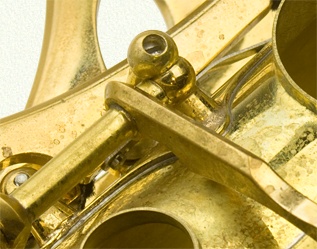 This
is an issue both in terms of fit and finish, and in respect of long-term
reliability. You might not know it but pillars wear. Whenever you
press a key down the rod screw moves ever so slightly, and over
a period of time it widens the diameter of the hole in the pillar.
This is why vintage horns often need to have pillars bushed - or
oversized rod screws fitted. A pillar like this is going to wear
quicker than one in which the rod screw contacts the entire surface
of the hole drilled through it. Yes, it'll take a long time....but
it'll still happen. This
is an issue both in terms of fit and finish, and in respect of long-term
reliability. You might not know it but pillars wear. Whenever you
press a key down the rod screw moves ever so slightly, and over
a period of time it widens the diameter of the hole in the pillar.
This is why vintage horns often need to have pillars bushed - or
oversized rod screws fitted. A pillar like this is going to wear
quicker than one in which the rod screw contacts the entire surface
of the hole drilled through it. Yes, it'll take a long time....but
it'll still happen.
So it's not something to worry about for now - but it's still sub-standard
on a horn of this price, and I often wonder how it comes about.
I mean, if I were making up a set of rod screws for this horn I'd
thread a long piece of stock up, fit it to a key then mark where
it needs to be cut so that the head lies flush with the pillar.
Repeat as necessary. If I were making screws for more than one horn
I'd take a set of measurements from the first one and make the next
set to those dimensions. I might even knock up a jig so's I didn't
have to measure anything again. It's simple and obvious, surely?
So what's going wrong? Is it perhaps that the factory only has a
selection of sizes in stock - and that's yer lot? It can't be that
they're fitting the rods into the wrong keys because for as many
keys that have short rod screws you'd see others with the head of
the screws sticking out of the pillars.
 And
what of the 'reassembly' process? As discussed earlier I can well
imagine people having an issue at shelling out many thousands of
pound for, essentially, a Chinese/Taiwanese horn - but the big selling
point of this horn is that it's given a thorough post-manufacturing
workover. So why weren't such issues addressed at that point? For
four grand I want to see properly-sized rod screws please. And
what of the 'reassembly' process? As discussed earlier I can well
imagine people having an issue at shelling out many thousands of
pound for, essentially, a Chinese/Taiwanese horn - but the big selling
point of this horn is that it's given a thorough post-manufacturing
workover. So why weren't such issues addressed at that point? For
four grand I want to see properly-sized rod screws please.
The point screws are of the pseudo type, and our
old friend the sprung insert has popped up again. Or should that
be popped out?
I've railed against these things in a number of reviews now, but
the thing that really, really annoys me is that if you're going
to use the poxy things could you at least ensure that the inserts
are held captive on the springs? Because if they're not, the damned
thing are liable to pop out of the key barrel with some force when
you take a key off and disappear into the wide blue yonder.
Notwithstanding the fact that this system gives the point screw
mounted key a mediocre fit I can at least report that none of them
suffered with the binding issue I've seen on a few other horns (Borgani
in particular)...whereby the insert gets jammed in the key barrel
and renders the whole system ineffectual. So plus points there,
I suppose.
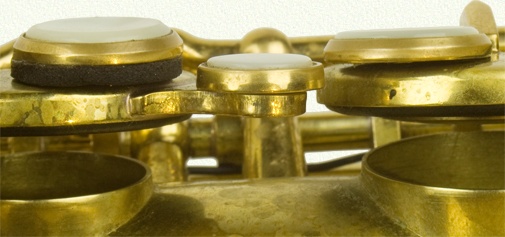 A
quick note about the key pearls. They're proper mother of pearl,
only very slightly concave in profile with flat ovals for the side
F# and G# touchpieces. The Bis Bb pearl is equally slightly domed
- and I think they've missed trick here. The transition from B to
Bis Bb isn't too bad - you're not likely to catch your finger in
the gap - but take a look at the pearl holders. A
quick note about the key pearls. They're proper mother of pearl,
only very slightly concave in profile with flat ovals for the side
F# and G# touchpieces. The Bis Bb pearl is equally slightly domed
- and I think they've missed trick here. The transition from B to
Bis Bb isn't too bad - you're not likely to catch your finger in
the gap - but take a look at the pearl holders.
On the B and A keys there's a chamfer leading
up to the pearl, but on the Bis Bb the holder is rather more cylindrical.
This makes no sense to me, especially with a relatively flat pearl
fitted. And I use the term loosely because the pearl's a touch undersized
for its holder. Put a chamfer on it and stick a larger and more
domed pearl in it and it'd make a nice improvement to the feel of
the action.
 You
get a tilting bell key table mounted on a fixed semicircular compound
bell key pillar - which should be sturdy enough to shrug off all
but the most severe knocks and bashes. Nothing to complain about
here - but I spotted something a little unusual down at the lower
end of the low C# lever. You
get a tilting bell key table mounted on a fixed semicircular compound
bell key pillar - which should be sturdy enough to shrug off all
but the most severe knocks and bashes. Nothing to complain about
here - but I spotted something a little unusual down at the lower
end of the low C# lever.
What you're looking at here is the low C# cup
key - and the spring that lifts it up when you press the C# key
down. What's strange about this is that there's no dedicated cradle
for the spring to sit in. Rather, it has to sit in the cutaway that's
provided for the adjusting pin (which can be moved to set the height
of the C# touchpiece).
 There's
no particular problem with this, it's just that I've never seen
it before - and as such it's a 'tell'. There's
no particular problem with this, it's just that I've never seen
it before - and as such it's a 'tell'.
A tell is a feature that can help to identify
who made a horn. Remember those mystery vintage horns I mentioned
at the top of the review? Sax sleuths use tells such as the layout
of the bell keys or the design of the bell brace to point to a particular
maker. It's not always entirely conclusive though, but if you can
spot enough tells on a horn it's generally a reasonably accurate
way of working out its origins.
And what does this tell say about this horn? I dunno. 'cos I've
never seen this feature before - but I would say that features like
this, the point screw inserts, the short rod screws and the iffy
solderwork make for a handy checklist that might come in useful
one day.
There are no stack adjusters on the horn (for
regulation and/or key height) which is a bit disappointing, but
you do get the usual trio of adjusters for the G#, Bis Bb and low
C# - plus adjustable pins for the front top F and low C# levers.
 I'm
very pleased to see simple and efficient fork and pin connectors
on the side Bb and C keys but not that thrilled about the dinky
little sling ring. Would another couple of millimetres or so have
killed them? I find small sling rings can be a bit faffy when you're
in a hurry, and in some instances can limit which brand of sling/neckstrap
you can use. I'm
very pleased to see simple and efficient fork and pin connectors
on the side Bb and C keys but not that thrilled about the dinky
little sling ring. Would another couple of millimetres or so have
killed them? I find small sling rings can be a bit faffy when you're
in a hurry, and in some instances can limit which brand of sling/neckstrap
you can use.
The pads are of excellent quality, being black
Pisoni Pros. They've been fitted with custom oversized solid brass
reflectors with a matt finish. Looks very swish.
Better still, plenty of glue (hot melt glue in this instance) has
been used to set the pads in place. I know I make a fuss about such
things but it really does make a lot of difference when you have
to reset a pad. Nothing worse than trying to tease a leak out of
a pad seat and then finding that there's not enough glue behind
the pad to retain the reset in place.
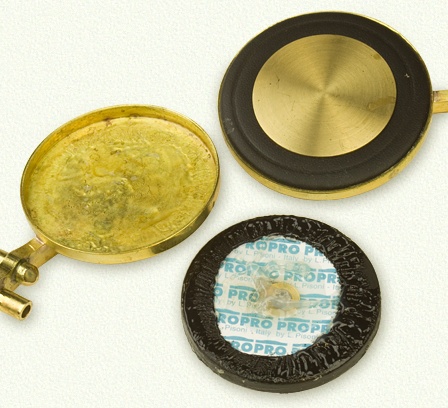 Wrapping
up the action is a set of blued steel springs to power it and a
good combination of neatly-applied felt and synthetic keywork buffers.
And you might have spotted that there's no top F# key on this horn
- and if that's a dealbreaker for you, don't worry...it's available
as an optional extra. Wrapping
up the action is a set of blued steel springs to power it and a
good combination of neatly-applied felt and synthetic keywork buffers.
And you might have spotted that there's no top F# key on this horn
- and if that's a dealbreaker for you, don't worry...it's available
as an optional extra.
Under the finger the action felt just fine. It's
clear that some time has been spent on setting the key heights and
the spring tension. It's swift and responsive - and due to the careful
choice of buffering materials, nice and quiet.
I noted no particular problems with the layout of the keys.
When the horn came in I gave it an initial play-test
to see what sort of character it had, and was rather disappointed.
It seemed a bit stuffy and lacklustre. A subsequent examination
revealed the extent of the tonehole problem - which struck me as
something of a great shame given that it was clear to see that quite
some time and effort had been spent installing and seating the pads.
But this is the nature of uneven toneholes; you can use various
techniques to mould the pads around such discrepancies but sooner
or later the pads are going to move. They'll shrink and expand over
the course of getting wet and drying out, and they'll also relax
a little over time. So the horn comes off the workbench working
just fine. It'll still work fine when you try it out in the shop
- and it'll still work fine once you get it home and put it through
its paces at a few gigs. And then it slowly starts to lose its edge
and responsiveness - and you probably won't even notice it because
your embouchure learns to compensates for it.
If you're lucky it'll carry on working in this fashion for quite
a while - but if you're not you'll find that there comes a time
when you start to struggle (usually starting with the low notes).
And if you're really unlucky you'll take it along to a repairer
who blows half a dozen notes on it, shoves a leaklight down it and
says "Ye Gods! Leaks like a bloody sieve!"
Once the leaks had been sorted out I was better
able to give the Remy a fair crack at showing what it could do -
and straightaway I ran into a bit of a 'gotcha' on the side Bb key.
I was running though a chromatic scale on the play-test when the
horn suddenly stopped dead in its tracks. Couldn't get anything
below A. And here's why.
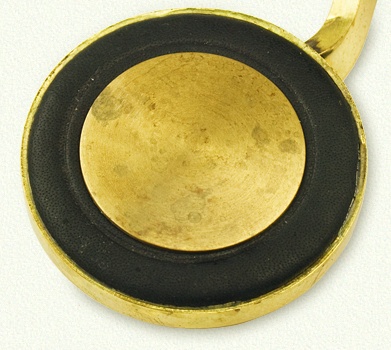 The
oversized reflector had just caught the edge of the tonehole and
was preventing the key from closing. A close inspection shows that
the reflector is barely smaller than the pad impression. Nothing
wrong with that...as long as you can ensure that the key never gets
knocked or the action doesn't wear. In the case of the side key
both things are extremely likely - with the latter being inevitable
sooner or later. I'd suggest shaving a couple of millimetres off
the diameter of the reflector just to give it a bit of leeway. A
subsequent knock or looseness in the action might well result in
a small leak, but it wouldn't stop the horn dead. Very much an accident
waiting to happen. The
oversized reflector had just caught the edge of the tonehole and
was preventing the key from closing. A close inspection shows that
the reflector is barely smaller than the pad impression. Nothing
wrong with that...as long as you can ensure that the key never gets
knocked or the action doesn't wear. In the case of the side key
both things are extremely likely - with the latter being inevitable
sooner or later. I'd suggest shaving a couple of millimetres off
the diameter of the reflector just to give it a bit of leeway. A
subsequent knock or looseness in the action might well result in
a small leak, but it wouldn't stop the horn dead. Very much an accident
waiting to happen.
Once I'd got that sorted I set to putting the
horn through its paces, and I believe the expression I'm looking
for is "Goodness me!"
I'd pulled out three other horns by way of a comparison; my TJ RAW,
a 992 Yanagisawa and a Purple Logo Yamaha 32. The latter was a bit
of wild card, but I though it might add a bit of perspective. It
never really had the chance, and nor did the 992.
I started off by playing a few licks and runs
on the RAW, then switched to the Remy...and found myself wondering
if I'd actually switched horns. The response is that close.
I really had to dig deep to eke out the differences but I got there
in the end. Tonewise the Remy is what I'd call a straight-ahead
tenor. Nicely balanced, not too dark nor too bright. Evenly toned
(with a slight shading on the middle D...but that's not uncommon,
and familiarity with the horn will iron that out) with just a touch
more blowing resistance than the RAW.
And I think pretty much all the difference lies in that resistance.
The RAW is a little more open, perhaps a tad louder with just a
hint more sparkle down at the lower end. But it's close, so very
close - and if I didn't know it was the Remy I was playing rather
than the RAW I would have said that I felt my reed was just starting
to signal that it was on the turn.
Now, I can see how the RAW appeals to so many players - but by the
same token the Remy surely will too. It's just a tiny touch more
reserved and gives you a little bit more to push against.
And if you're wondering whether that's a good thing it's pretty
much how a Selmer MkVI presents itself (to me, at least). It's not
a horn that gets in your way, though, and that's a very fine quality.
 And
that perhaps should come as no surprise because the ethos behind
this horn was to produce a 'modern' MkVI. Have they pulled it off?
It's difficult to say. As much as I like the MkVI, it's not a horn
I choose to play; there are some things about it that just don't
float my boat. But there are some other things about it that I really
do like - and so I chose a horn that has those things...and not
the ones I don't care for. I would say that the Remy, for me, meets
that criteria...which begs the question "What doesn't it have
that the MkVI does?" And
that perhaps should come as no surprise because the ethos behind
this horn was to produce a 'modern' MkVI. Have they pulled it off?
It's difficult to say. As much as I like the MkVI, it's not a horn
I choose to play; there are some things about it that just don't
float my boat. But there are some other things about it that I really
do like - and so I chose a horn that has those things...and not
the ones I don't care for. I would say that the Remy, for me, meets
that criteria...which begs the question "What doesn't it have
that the MkVI does?"
Well, that's the rub. Part of what makes a MkVI a MkVI are its flaws.
It's not a perfect horn. The reason the Selmer SA80 isn't a MkVI
is because Selmer wanted to iron some of those flaws out (as the
rest of the market was doing at that time).
But I said that the Remy was a straight-ahead tenor - and to my
mind (feel free to completely disagree) the Selmer MkVI is the archetypal
straight-ahead tenor. So rather than get bogged down in tonal nuances
I tend to go straight for the feel. I want a horn that's more evenly-balanced,
I want more reliable tuning - but I still want that 'head down,
get on with it' feel.
I didn't really bother with the 992 and the 32. Oh, I gave them
a cursory blow but there really didn't seem to be much point. When
a horn blows this well comparisons are rather moot. It's a great
player - you might like it, you might not. T'was ever thus...but
like the RAW it's definitely worth making the effort to find out.
And if you're hovering between the two, here's
another consideration. The RAW is a hefty horn - it weighs in at
3.5kg, which makes it on the heavy side compared to the rest of
the market. The Remy is a very sprightly 3.17kg - so if you like
the RAW but don't feel you can manage the weight, the Remy is going
to be a very good bet.
So it gets the old thumbs up - but with some important
caveats.
The Remy comes in at a touch over four grand, which puts it up against
some fairly big hitters. There's the Yanagisawa TWO1 at just under
four grand and the Yamaha 82Z at a few hundred pounds more than
the Remy. Filling in the rest of the gaps you have an Eastman, a
Rampone and a few Mauriats. And you have the TJ RAW at just over
three grand. It's certainly true to say that the build quality of
the Yamaha, Yanagisawa and TJ RAW exceeds that of the Remy (out
of the box) - and that's a worthy consideration I always recommend
buyers to take into account.
However, there's a somewhat personal element involved with this
horn inasmuch as it was bought at a time when the builder, Remy
Veerman, was dealing with illness and other problems...and the horn
was purchased at a very favourable price. There's a saying in the
industry - "You're only as good as your last job", and
in the case of makers or builders I guess you could say "You're
only as good as the last horn you made" - but I'm going to
cut some slack on the review and say that the build quality on newer
models is likely to be that much better. There are still some issues
that could do with sorting out but I wouldn't consider them to be
game-changers. But, of course, I'll add to this review if and when
other examples come my way.
In the meantime the Remy is a very, very capable
horn that won't put your back out, and one that's likely to appeal
to players who want at least some of that whole MkVI thing - and
it's individual enough to make the price more palatable.
Update December 2023
Another Remy tenor turned up on the workbench
for a thorough shakedown after the owner, who bought it direct from
the manufacturer, had seen the above review and felt that his horn
was underperforming.
This one's a slightly later model, but only by a few hundreds difference
in the serial range - and I was quite keen to see whether the problems
that hampered the earlier model would be in evidence on this one.
And, alas, they were - but to a slightly lesser degree.
 The
first thing I noticed was that there was quite a lot of free play
on the thumb key, and this proved to be down to incorrect placement
of one of the pillars. The
first thing I noticed was that there was quite a lot of free play
on the thumb key, and this proved to be down to incorrect placement
of one of the pillars.
You can sometime swedge a bit of free play out of key barrel that's
mounted on point screws, but it's a bit of an ask to remove this
much play. In any event the sprung inserts preclude that particular
technique (at least not without having the ream the bores for the
inserts out again), so the simplest solution was to move a pillar.
On a lacquered or plated horn this would be something of a disaster
- but on a bare brass horn it's a simple matter of unsoldering one
of the pillars, moving it slightly and resoldering it. Clean and
polish the joint and let it tarnish to match the rest of the horn...and
you'd never know there'd been a fix.
 There's
some evidence of swedging work on many keys, though I'm pleased
to report that the burrs on the key barrel faces weren't in evidence. There's
some evidence of swedging work on many keys, though I'm pleased
to report that the burrs on the key barrel faces weren't in evidence.
The palm and side keys were particularly bad in
terms of free play - even after the swedging - so-much-so that I
felt it necessary to replace the rod screws with oversized ones
in order to not only take up the play in the key barrel but also
the pillars. And it wasn't 'just a bit' of play. On most rod screw
upgrade jobs you'd be looking at stepping up the diameter by one
notch. In this case the rod screws measured 2.48mm across the diameter.
The next standard size up is 2.56mm, but there was so much free
play in the pillars that I had to jump up another step to 2.62mm.
That's the sort of jump you'd expect to see on a 50+ year old horn
that's been around the block a few times.
 The
problem with the overly-short rod screws on the palm and side keys
remains, with the side C key being particularly badly affected. The
problem with the overly-short rod screws on the palm and side keys
remains, with the side C key being particularly badly affected.
The head of this screw was more than halfway deep in the pillar.
Not good.
Thing is, you wouldn't have noticed - because at first sight the
screw appeared to be more or less flush with the face of the pillar...but
it was only like this because it hadn't been fully screwed in. That's
a bit naughty.
This theme continues for most of the keywork to
varying degrees, with some notable free play spotted on the Auxiliary
F key. This is an especially nasty place to have wear because this
key only closes by virtue of a link to the low F, E and D keys.
What that means is that the Aux.F can only come down over the tonehole
as far as any of the other three keys will allow...at which point
the spring pushes back against the free play and a leak appears.
So that's everything below F working at less than 100%.
 I
spotted our old friend - the crimped rod screw head - on the low
C/Eb key. I
spotted our old friend - the crimped rod screw head - on the low
C/Eb key.
We've seen this on a few other boutique horns in the past and its
function appears to be to splay out the head of the rod screw in
order to disguise a poor fit in the pillar. Which was a bit odd
because this screw was a decent fit. Go figure.
The toneholes were still below par. Not quite
as bad as on the previous example but still well outside what should
be considered acceptable. Here's the low D, which was pretty much
the worst example on the horn. That gap on the right side of the
hole measures out at 0.25mm...which is around 10 times the size
of a gap that would constitute a leak.
 As
I say, this was the worst - but there wasn't a single tonehole on
the horn that didn't require some levelling. As
I say, this was the worst - but there wasn't a single tonehole on
the horn that didn't require some levelling.
On the plus side I can report that the soldering
on this example was a great deal tidier than on the last example
- but it's still concerning to see build quality issues turning
up a few hundred horns down the line. In the horn's defence I can
say that it was purchased at a seemingly low price, which might
suggest it had been outed as 'B stock' - thought the client has
no recollection of that being mentioned at the time of purchase.
From my perspective that takes quite a lot of the sting out of the
deal. It's a nice horn at the end of the day, and if you can pick
one up for a fair price and throw a few hundred quid at it to bring
it up to spec you've got a good horn that's a bit of a bargain.
But if later models turn up at full price that still exhibit these
build issues they're going to get properly roasted...
|

